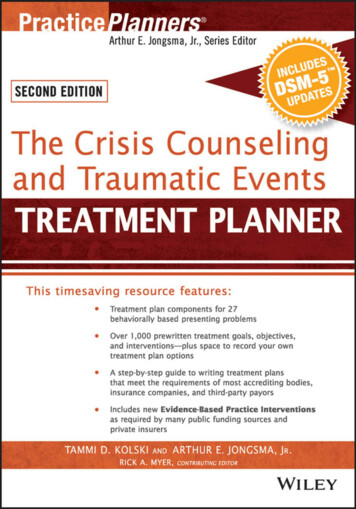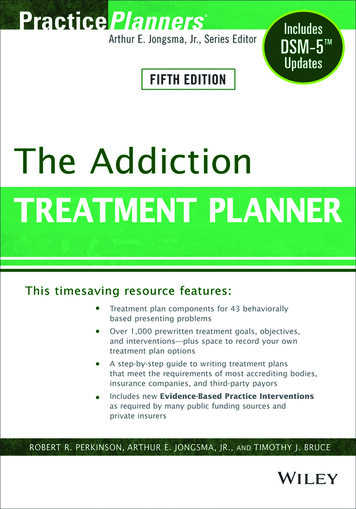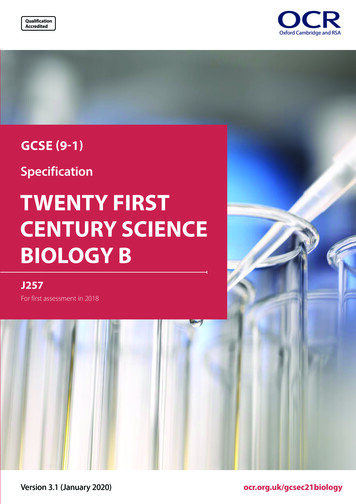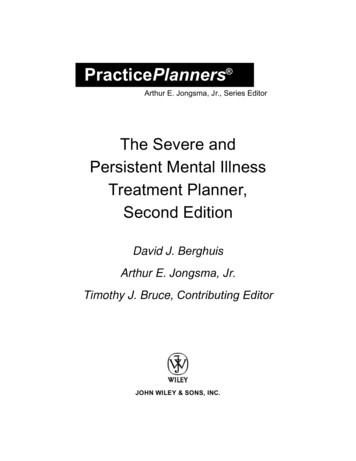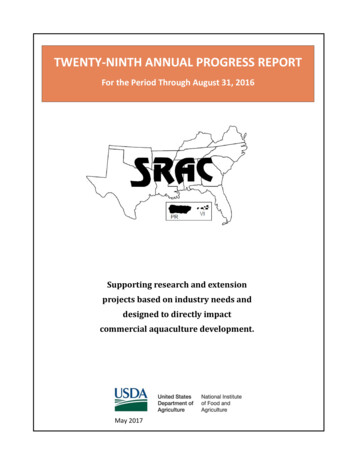
Transcription
TWENTY‐NINTH ANNUAL PROGRESS REPORTFor the Period Through August 31, 2016Supporting research and extensionprojects based on industry needs anddesigned to directly impactcommercial aquaculture development.May 2017
TWENTY‐NINTH ANNUAL PROGRESS REPORTUSDA NIFA SOUTHERN REGIONAL AQUACULTURE CENTERDr. Jimmy Avery, DirectorP.O. Box 197Stoneville, Mississippi 38776Phone: 662‐686‐3273Fax: 662‐686‐3320E‐mail: srac@drec.msstate.eduhttp://www.srac.msstate.edu/
TABLE OF CONTENTSEXECUTIVE SUMMARY . 1INTRODUCTION . 5ORGANIZATIONAL STRUCTURE . 7PROGRESS REPORTS . 11Publications, Videos, and Computer Software . 11Performance Evaluation of Intensive, Pond‐Based Culture Systems for Catfish Production. 13Split‐Pond Aquaculture Systems: Design Refinements for Catfish Production andEvaluation for Culturing Other Species . 15Improvement of Blue Catfish Germplasm for Hybrid Catfish Production . 19Studies to Improve the Control of Virulent Aeromonas hydrophila and Evaluate theImpact of Environmental Factors on its Abundance in Catfish Aquaculture Ponds . 21Integrated Approaches to Reducing Individual Variability and Providing Year RoundHarvest of Channel‐Blue Hybrid Catfish . 25Evaluation of Probiotic and Prebiotic Supplements with Catfish, Golden Shiners, HybridStriped Bass, and Tilapia under Conditions of Commercial Production . 27Improved Reproduction in Foodfish (Catfish and Largemouth Bass), Baitfish, andOrnamentals Using a New Spawning Aid (GnRH IIa) . 29Predation Risk and Economic Impact of Lesser Scaup and Piscivorous Waterbirds onCommercial Baitfish and Catfish Production . 31PRODUCTS DEVELOPED AND STUDENTS SUPPORTED. 33Journal Articles . 33Extension/Outreach Publications . 33Oral Presentations . 34Poster Presentations . 37Digital Products . 37Students Supported . 37APPENDIX 1. LIST OF COMPLETED SRAC PROJECTS TO DATE . 39i
ii
EXECUTIVE SUMMARYThis Twenty‐ninth Annual Progress Report seeks to provide a summary of work completed and outreachactivities of the Administrative Center during the past year. Full progress reports on the 9 multi‐yearresearch and Extension projects supported by SRAC during this reporting period are available s.html. In the past year, SRAC funded projectstotaling more than 2.2 million. During the past year, these projects have resulted in 10 journal articles,7 Extension/Outreach publications, 30 oral presentations, 1 poster presentation, 3 digital products, andhas supported 20 students.The Center’s Publications project is in its twentieth year of funding. Seven new fact sheets and the newSRAC Aquaponics website were completed while several fact sheets are in the process of review orrevision. The SRAC publications and AquaPlant websites were also updated with new materials. To date,the project has generated 294 technical fact sheets (276 in the current catalog), 89 update revisions, 7web presentations, 7 software programs or web tools, and 31 videos through the SRAC PVCS Project. Inthe current reporting year alone, 47,492 unique users from 170 countries and territories used the SRACPublications website to view or download SRAC publications 233,342 times. SRAC videos were viewedon the SRAC YouTube channel 43,099 times during the current reporting period. The AquaPlant website,created with funding from the SRAC PVCS Project, had 312,349 unique users that viewed 2,507,344webpages during the reporting period.The “Intensive, Pond‐based Culture Systems” project evaluated the production efficiencies of three newcatfish production systems; smaller conventional earthen ponds with increased aeration rates, split‐pond systems, and in‐pond raceways. The comprehensive database that is emerging from this projectwill be a valuable guide for farmers considering investing in the new systems. The intensive monitoringof this project has documented extremely high fish production but also high variability. In most casesnet production exceeded 12,000 lbs/acre with FCRs better than 2.0:1, with production up to 17,000‐19,000 lbs/acre in the best cases. This dataset provides a more complete picture of the comparativeproduction and economic benefits of these systems than has previously been available, and enablesExtension personnel to better assist farmers to make informed decisions related to adoption of thesenew technologies. There have been 31 presentations (most with published abstracts) to scientific andindustry groups, with many more planned.The “Split‐Pond Aquaculture Systems” project is evaluating important design or management optionsfor producing catfish, including pumping systems and oxygen management, and has developedengineering design criteria for baitfish aquaculture. Since project initiation, many farmers have touredthe Stoneville facility specifically to observe the four pumping systems installed in the split‐ponds. Atleast two farmers from Arkansas have decided to use a paddlewheel aerator pumping system tocirculate water in split‐ponds that are currently being constructed on their farms. Five additional split‐ponds have been constructed in addition to 13 split‐ponds at three cooperating catfish farms inArkansas. Currently, a baitfish farm has built a commercial size split‐pond to raise fathead minnows andharvested the first crop this year. Split‐pond technologies have been further expanded to largemouthbass culture. A largemouth bass farm in McCrory, AR is planning to install split‐ponds for largemouthbass food‐fish production in conjunction with in‐pond raceway technologies for largemouth bass stockerproduction in 2016. Outreach has been extensive. Twenty‐five presentations have been made atproducer and professional meetings on technologies developed in this project. An additional 8publications have been published or are accepted for publication.1
The objectives of the “Blue Catfish Germplasm” project are to develop a repository of cryopreservedsperm from diverse blue catfish populations to initiate genetic improvement of hybrid catfish and todevelop a database for efficient storage and retrieval of cryopreserved blue catfish sperm andassociated information. During the spring of 2016 sperm samples from 60 mature blue catfish malesfrom 3 strains were collected. Cryopreserved sperm samples were successfully used to produce full‐ andhalf‐sib families of blue catfish and hybrid catfish progeny that will be the basis for estimating geneticeffects of blue catfish males on purebred blue catfish and hybrid catfish progeny. Progeny have beenstocked in earthen ponds and will be measured for growth and carcass yield. The data will be evaluatedto identify mating strategies that will involve use of cryopreserved sperm samples to produce superiorpurebred blue catfish germplasm for release to catfish farmers. Thus far there have been 4 formalpresentations to scientific and industry groups, with many informal discussions with individual hybridcatfish fry producers.The “Control of Virulent Aeromonas hydrophila” project will help identify the environmental and humanfactors that contribute to its spread, develop effective disinfection and management practices that canresult in improved biosecurity, and develop control measures for farms afflicted with this epidemic.Quantification of vAh in pond water, sediment, and aquatic invertebrate or fish samples revealed thesampling protocols employed are sufficient to detect vAh in the system. This analysis suggested that acarrier state can occur in fish that have survived vAh outbreaks. It is possible for Great Egrets that haveconsumed fish with vAh to spread the bacteria to naïve ponds and initiate a disease outbreak. Thebacterium was also able to attach and form biofilm in man‐made material although there weresignificant differences in terms of biofilm formation between the different substrates tested. The vAhymcA deletion mutant was determined to be highly attenuated in its virulence in the same batch offingerling catfish used for a production pond study, and both the vaccinated fish and the probiotic‐fedfish showed a significant increase in survival relative to naïve control fish in aquaria disease challenges.Results of this research will be the foundation of more targeted field sampling to provide more resoluteevaluations of pond conditions associated with disease outbreaks.The “Integrated Approaches to Reducing Individual Variability and Providing Year Round Harvest ofChannel‐Blue Hybrid Catfish” project seeks to evaluate the impact of culture system, harvest technology,fingerling size and variability, grading, genetics, time and rate of stocking and feeding rate on sizevariability at harvest and the ability to accomplish year‐round harvest. The results are quite preliminaryand additional replication is needed. At this point in time the data indicates that the genetic strain of theparent species affects variability in the hybrid. Both sire and dam effects were significant. Genotype‐environment interactions affect the body weight variability. However, environment was more importantthan genetics in causing variability. The coefficient of variability for body weight was significantlyaffected by whether the pond was partially or completely harvested, the length of the culture period,the amount of aeration, feeding rate, stocking density, production, genetics, grading of fingerlings, andthe number of feeding days. Stocking density, production, pond depth, pond size, and stocking weighthad the largest effects on the percentage of undersized fish. The amount of aeration, grading offingerlings, satiation feeding, feeding days per week and protein level of the feed had the largest effectson the oversized fish. Traditional ponds, both single batch and multi batch, split‐pond and racewayculture systems produced hybrid catfish with similar body weight variability, percentage of under‐sizedfish, and percentage of oversized fish. The percentage of undersized and oversized fish has a very largeimpact on farm profitability. Assuming various price structures for undersized and oversized fish anddifferent observed percentages of each, the cost of production can be affected by as much as 40‐70%.2
The “Evaluation of Probiotic and Prebiotic Supplements” project is designed to evaluate a commerciallyavailable prebiotic and probiotic under conditions simulating commercial production with prominentfish cultures in the southern region including hybrid catfish, golden shiners, and hybrid striped bass inponds and tilapia in recirculating aquaculture systems. Neither of the prebiotic or probiotic supplementseither singularly or in combination significantly altered weight gain, feed conversion ratio, or survival ofthose species. However, the microbiota of the gastrointestinal tract of hybrid striped bass was affectedby the supplements, as were several innate immune responses. The prebiotic supplement had a greaterinfluence on these responses than the probiotic. The controlled bacterial challenges conducted witheach of those fish did not result in significant mortality, even in fish fed the basal diet. This was likely doto the non‐invasive manner in which the fish were exposed to the pathogens. Additional diseasechallenges are planned with hybrid striped bass and golden shiners to more stringently evaluate the dietsupplements.The overall goal of the “Improved Reproduction in Foodfish (Catfish and Largemouth Bass), Baitfish, andOrnamentals Using a New Spawning Aid (cGnRH IIa)” project is to identify an effective dosage(s) GnRHIIa which will successfully induce spawning, result in higher female spawning occurrence than currentlyobserved, and potentially lead to increased larval output compared to current hormonal inductionstrategies for each species. At the end of the reporting period, this project was less than 3 months along.Therefore, participants were not asked to provide summary results/outcomes.The “Predation Risk and Economic Impact of Lesser Scaup and Piscivorous Waterbirds on CommercialBaitfish and Catfish Production” project will improve understanding of utilization of baitfish ponds bylesser scaup, species and sizes of fish consumed, and will ultimately generate an economic analysis ofbaitfish losses. This project will also generate contemporary information on cormorant roost locations,numbers of birds per roost, and roost distance from active and inactive catfish ponds in Mississippi aswell as reveal how cormorants modify their use of roost sites as commercial aquaculture decreases.Ultimately, results from this study will allow researchers to estimate economic losses of fish caused bythese birds, and generate management recommendations for producers to ameliorate depredation offish by waterbirds. At the end of the reporting period, this project was less than 2 months along.Therefore, participants were not asked to provide summary results/outcomes.3
4
INTRODUCTIONMissionThe mission of the USDA NIFA Southern Regional Aquaculture Center (SRAC) is to support aquacultureresearch, development, demonstration, and education to enhance viable and profitable U.S.aquaculture production to benefit consumers, producers, service industries, and the Americaneconomy. Projects that are developed and funded are based on industry needs and are designed todirectly impact commercial aquaculture development in the southern region and the nation.BackgroundThe Agriculture Acts of 1980 and 1985 authorized establishment of aquaculture research, development,and demonstration centers in the United States. With appropriations provided by Congress for the 1987and 1988 FYs, efforts were undertaken to develop the five Regional Aquaculture Centers now inexistence. Organizational activities for SRAC began in 1987, with the first research and Extensionprojects initiated in 1988.In 1980, Congress recognized the opportunity for making significant progress in domestic aquaculturedevelopment by passing the National Aquaculture Act (P.L. 96‐362). The Act established USDA as thelead agency for aquaculture coordination and called for development of a National Aquaculture Plan.The next year, Congress amended the National Agricultural Research, Extension, and Teaching Policy Actof 1977 (P.L. 95113) by granting, in Title XIV, Subtitle L, Sec. 1475(d) of the Agriculture and Food Act of1981 (P.L. 97‐98), authority to establish aquaculture research, development, and demonstration centersin the United States.Congress envisioned the Centers as focal points in a national program of cooperative research,Extension, and development activities that would be developed in association with colleges anduniversities, state Departments of Agriculture, federal facilities, and non‐profit private researchinstitutions with demonstrated excellence in aquaculture research and Extension. Eventually, five suchCenters were established: one in each of the northeastern, north central, southern, western, andtropical Pacific regions of the country.Although government agencies, particularly the United States Department of Agriculture, have providedsignificant support for aquaculture research and development, much of that funding is earmarked forspecific use by specific institutions. The USDA NIFA Regional Aquaculture Center program is the onlyfunding activity with the flexibility to stay abreast of industry development, identify problems on aregion‐wide scale, and implement cooperative, interstate projects to solve those problems.Since its inception in 1987, SRAC has become the most important regional aquaculture activity in thesoutheastern United States. In its 29 years of operation, the Center has disbursed more than 18.2million to fund multi‐state research and Extension projects. More than 200 scientists from 30institutions in the southeast have participated in Center projects.Productivity from SRAC research projects has been excellent since the Center’s inception more than twodecades ago. Information derived from SRAC‐funded projects has been transferred to producers and5
other scientists in thousands of scientific papers and presentations. Currently funded projects continuethis trend of high productivity.Beginning with the first projects funded by SRAC, interest among aquaculture research and Extensionscientists in Center activities has been excellent. In fact, funding and project coordination provided bySRAC has become so embedded in the fabric of southeastern aquaculture research and Extension that itis difficult to envision what these activities would be like without the program. We are pleased with theparticipation by our research and Extension scientists in the Southern Region in ad hoc Work Groupmeetings and Steering Committees, and their willingness to serve as Project Leaders and PrincipalInvestigators for the projects. We believe this broad‐based representation has resulted in strong,cooperative research that will be of long‐lasting benefit to aquaculture producers and consumers, andto the growth of the aquaculture industry in the Southern United States.AcknowledgmentsThe Southern Regional Aquaculture Center acknowledges the contributions of the Project Leaders andParticipating Scientists involved in the projects reported in this Twenty‐ninth Annual Progress Report.Members of the SRAC Board of Directors, Industry Advisory Council, and Technical Committee haveprovided valuable inputs to the successful operation of SRAC during the past year. We particularlyappreciate the assistance of the chairs of these vital committees.We also thank the scientists and aquaculturists from across the country who contributed their expertiseand valuable time to review SRAC project proposals and publications. Without their help, it would beimpossible to maintain the high quality of this program.6
ORGANIZATIONAL STRUCTUREResearch and Extension problem areas for the southern region are identified each year by the IndustryAdvisory Council (IAC), which consists of fish farmers and allied industry representatives from across theregion. The Technical Committee (TC), consisting of research and Extension scientists from states withinthe region, works with the IAC to prioritize problem areas. The two groups then work together todevelop “Requests for Pre‐proposals” describing objectives of work to solve problems with the highestpriority. The best proposals submitted by individuals or teams are used to form a regional Work Groupthat plans and conducts the work. Regional aquaculture funds are allocated to participants in SRACprojects approved by the Board and NIFA. Reviews of project proposals, progress reports, andrecommendations for continuation, revision, or termination of projects are made jointly by the TC andIAC and approved by the Board.The thirteen states and two territories represented by SRAC are Alabama, Arkansas, Florida, Georgia,Kentucky, Louisiana, Mississippi, North Carolina, Oklahoma, Puerto Rico, South Carolina, Tennessee,Texas, U.S. Virgin Islands, and Virginia.Administrative CenterThe Administrative Center is located at the Delta Research and Extension Center, Stoneville, Mississippi.Mississippi State University serves as the Host Institution. All necessary support services for the Board,IAC, TC, Steering Committees, and project Work Groups are provided by the Administrative Center. Thisincludes monitoring status and progress of projects, preparing and executing Letters of Agreement,tracking administrative and project expenditures, reviewing progress reports, and assisting ProjectLeaders and participating institutional Grants Offices as needed.Operation and funding are approved by the Board for inclusion in the Grant Application submittedannually to USDA NIFA. The Center staff also prepares and submits to USDA NIFA an Annual Plan ofWork covering Center activities and projects to be funded. Following final approval, Letters ofAgreement are prepared and executed with all participating institutions. The Center acts as fiscal agentto disburse and track all funds in accordance with the provisions of the grants.Board of DirectorsThe Board is the policy‐making body for SRAC. Membership provides an appropriate balance amongrepresentatives from State Agricultural Experiment Stations, Cooperative Extension Services, 1890Institutions, and the Administrative Heads Section of the Board on Agriculture Assembly of theAssociation of Public and Land Grant Universities.The Board is responsible for 1) overall administration and management of the regional center program;2) establishment of overall regional aquaculture research and Extension goals and allocations of fiscalresources to ensure that the center develops strong programs in both research and Extension; 3)establishment of priorities for regional aquaculture research and Extension education activities based oninputs from the TC and IAC; 4) review and approval of annual plans of work and accomplishmentreports; and 5) final selection of proposals for funding by SRAC.7
Members of the Board for the reporting period were:Gregory Bohach, Mississippi State UniversityPhil Elzer, Louisiana State UniversitySteve Lommel, North Carolina State UniversitySteve Martin, Mississippi State University Extension ServiceEd Jones, Virginia Cooperative Extension, Virginia TechGary Lemme, Auburn Cooperative Extension ServiceWes Burger, Mississippi State UniversityIndustry Advisory CouncilThe IAC is composed of representatives of state and regional aquaculture associations, federal,territorial and state agencies, aquaculture producers, aquaculture marketing and processing firms,financial institutions, and other interests or organizations. The IAC provides an open forum whereinmaximum input from private and public sectors can be gained and incorporated into annual and ongoingplans for SRAC.The IAC 1) identifies research and Extension needs; 2) works with the TC to prioritize research andExtension needs; 3) works with the TC to develop problem statements and recommend funding levelsfor projects addressing priority research and Extension needs; 4) reviews project proposals, progressreports, and termination reports; and 5) recommends to the Board, jointly with the TC, actionsregarding new and continuing proposals, proposal modifications, and terminations.Members of the IAC for the reporting period were:J. Neal Anderson, ARVaun Cummins, KYBen Pentecost, MSMartha Campbell, FLRob Ellis, NCMarty Tanner, FLTravis Wilson, ALTownsend Kyser, ALRalph Babin, TXAnthony Marchetti, VAChris Bently, VAKim Edge, GAStephen Sagrera, LAShorty Jones, MSChase Holub, TXFrank Roberts, SCJoey Lowery, ARJenny Davis Fagan, TNWes Hardin, OKTechnical CommitteeThe TC consists of representatives from participating research institutions and state Extension services,other state or territorial public agencies as appropriate, and private institutions. Membership of the TCincludes research and Extension scientists representing essentially all states in the region. The TC 1)works with the IAC to prioritize research and Extension needs; 2) works with the IAC to develop problemstatements and recommend funding levels for projects addressing priority research and Extensionneeds; 3) reviews proposals, progress reports, and termination reports; and 4) recommends to the8
Board, jointly with the IAC, actions regarding new and continuing proposals, proposal modifications andterminations.Members of the TC for research for the reporting period were:Brian Bosworth, USDA‐ARS Warmwater Aquaculture Research CenterHarry Daniels, North Carolina State UniversityKen Semmens, Kentucky State UniversityAllen Davis, Auburn UniversityHerbert Quintero, University of Arkansas at Pine BluffDelbert Gatlin, Texas A&M UniversityTerry Tiersch, Louisiana State UniversityCortney Ohs, University of FloridaDan Kauffman, Virginia Tech UniversityMike Denson, South Carolina Department of Natural ResourcesBrian Alford, University of TennesseeMembers of the TC for Extension for the reporting period were:Lance Beecher, Clemson UniversityMike Frinsko, North Carolina State UniversityRon Blair, University of TennesseeGary Burtle, University of GeorgiaJesse Chappell, Auburn UniversityTodd Sink, Texas A&M UniversityGreg Lutz, Louisiana State UniversityMichael Schwarz, Virginia Tech UniversityCraig Watson, University of FloridaForrest Wynne, Kentucky State UniversityAnita Kelly, University of Arkansas at Pine BluffMark Peterman, Mississippi State UniversityMarley Beem, Oklahoma State UniversityDon Bailey, University of the Virgin Islands9
10
PROGRESS REPORTSPublications, Videos, and Computer SoftwareReporting Period: September 1, 2015 – August 31, 2016Length of Project: OngoingCurrent Project Year: 20Total Funds Committed: 41,430Principal Investigator: Todd Sink, Texas A&M UniversityRelevance: When this project was initiated, fewer than half the states had educational materialscovering the major aquacultural species in their state. The concept of using the SRAC program toproduce timely, high‐quality educational materials is based upon the benefits of centralizing theproduction process while using a region‐wide pool of expertise to develop materials. Distribution is thendecentralized through the nationwide network of Extension Specialists and County Agents including theNational eXtension Initiative. This process assures an efficient publication process that makes use of thebest available talent in specific subject areas.Response: A committee of Extension Specialists and researchers solicit input on publication and digitalproduct needs from their counterparts across the region. These suggestions are prioritized during anannual meeting of the committee based on need and available funding. The best talent from within andoutside the region are then recruited to submit proposals to develop these products.Results: The result is widespread availability of high‐qualityeducational materials for scientists, educators, producers,students, and the general public which in turn leads toincreased or improved efficiency aquaculture production,improved awareness of aquaculture products and thenutritional benefits of seafood, and increased aquacultureinvestment.Outreach Overview: SRAC fact sheets and videos aredistributed electronically, by direct request, and viaExtension Specialists, County Extension Agents, and otherRACs. These products are used regularly by clientele in all 50states as well as internationally in 206 countries andterritories. Fact sheets, videos, and web presentations are accessed daily from the SRAC Publicationswebsite and YouTube by people searching for technical information.Targeted Audiences: The target audiences for this project are educators, consumers, producers,potential investors, students, and the general public.Outputs: Seven new fact sheets and the new SRAC –aquaponics website were completed for thisreporting period. The SRAC publications and AquaPlant websites were also updated with new materials.All completed publications have been distributed electronically throughout the Southern Region and to11
interested Extension Specialists in other regions. Four additional fact sheet manuscripts were submittedto be published after the reporting period concluded.Outcomes/Impacts: Publications and videos produced by SRAC are increasingly used in educating highschool and college students about aquaculture. These programs heavily utilize SRAC publications andvideos for educational purposes but usage is impossible to measure because access to the information isgained from many different Internet sites, through file sharing, and digital downloads of PDFs.Another important impact is the education of local, state, and federal regulators about the aquacultureindustry. This impact is difficult to measure but feedback from personnel in two states have indicatedthat the fact sheets are recommended reading for all new employees dealing with aquaculture, waterquality, exotic species, and other permitting duties. This should be a positive influence toward makingaquaculturists better understood and the development of more enlightened regulations.The impact on consumers of aquaculture products is also likely s
The mission of the USDA NIFA Southern Regional Aquaculture Center (SRAC) is to support aquaculture research, development, demonstration, and education to enhance viable and profitable U.S. aquaculture production to benefit consumers, producers, service industries, and the American




